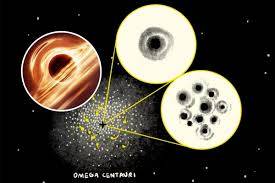Hidden Black Holes Solve Milky Way Mystery
For decades, scientists have struggled to understand some of the Milky Way’s most elusive and puzzling features. While astronomers have been able to map out galaxies with incredible precision, there have always been unexplained discrepancies in the motions of stars and gas within our galaxy. The discovery of hidden black holes, invisible to most traditional observational techniques, has provided a breakthrough in solving some of these mysteries.
Black holes are dense regions in space where gravity is so strong that not even light can escape. These enigmatic objects are typically found at the center of galaxies, with the supermassive black hole at the heart of the Milky Way, known as Sagittarius A*, being the most well-known. However, while supermassive black holes have long been understood, a new class of hidden, or "intermediate-mass," black holes is slowly revealing its impact on the dynamics of the Milky Way.
Astronomers have now hypothesized that many of these intermediate-mass black holes are scattered throughout the galaxy, hidden from conventional observation. Unlike their supermassive cousins, these black holes are typically between 100 and 1000 times the mass of the Sun and are much more difficult to detect. They do not emit the same radiation as large black holes, which are often surrounded by accretion disks that shine brightly in X-rays. As a result, these smaller black holes remain largely invisible unless they interact with their surroundings in a way that leaves subtle clues behind.
One of the significant mysteries these hidden black holes help solve is the unexplained motion of stars within the Milky Way. Observations over the past several years have shown that certain stars appear to be moving in strange ways, exhibiting speeds and trajectories that cannot be easily explained by the gravitational influence of known stars and objects. It’s as if there is an unseen force pulling them in unexpected directions. This "missing mass" problem led astronomers to suspect the presence of additional, unseen objects.
The discovery of intermediate-mass black holes could be the key to resolving this issue. These objects would provide the additional gravitational pull needed to explain the peculiar movements of stars. Using advanced techniques, such as gravitational wave detection and star-tracking systems, scientists have been able to identify several potential candidates for hidden black holes. Their gravitational effects on nearby stars can now be detected, offering indirect evidence of their existence.
Another breakthrough involves the detection of gravitational waves—ripples in space-time caused by the collision of massive objects like black holes. When two black holes merge, they send out waves that can be measured on Earth. The detection of such waves has revealed that intermediate-mass black holes might be more common than previously thought, providing further evidence of their role in the Milky Way’s structure.
These findings have profound implications not only for our understanding of the Milky Way but also for the broader field of astrophysics. Hidden black holes offer insights into the formation of galaxies, star systems, and even the evolution of space-time itself. Understanding how these objects influence the galaxy’s structure can help astronomers refine models of galaxy formation and the distribution of dark matter.
In conclusion, the discovery of hidden black holes scattered across the Milky Way is shedding light on long-standing mysteries of our galaxy. By influencing the motion of stars and gas, these black holes are helping to solve the puzzle of missing mass and guiding the way to a deeper understanding of the universe’s most enigmatic objects. As new technologies and methods continue to evolve, scientists expect even more revelations about the role of black holes in shaping the cosmos.


